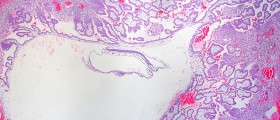
What Is Hysterectomy?Hysterectomy is a gynecological surgical procedure of removing the uterus. Hysterectomy is used in women with uterine fibroids, endometriosis, uterine cancer and other serious problems of female reproductive system that do not respond to other treatment options. It is the most commonly performed gynecological surgery and in 90% of the cases it is used for treating benign conditions. Hysterectomy can be done either vaginally or abdominally.
There are three types of hysterectomy. Partial or subtotal hysterectomy involves a removal of the uterus, leaving the cervix intact. Total hysterectomy is a removal of both the uterus and the cervix. Radical or complete hysterectomy is a surgery to remove the uterus, the cervix and the upper part of the vagina. It is performed when cancer is present. The ovaries, fallopian tubes and lymph nodes can be removed as well.
Complete Hysterectomy Overview
Complete hysterectomy is mainly performed if a woman suffers from cancer of the ovaries, uterus, endometrium or cervix. During the operation, a surgeon removes the uterus and the cervix, but if needed, the ovaries and the fallopian tubes may be removed as well. In this case, the operation is performed to prevent spreading of the cancer.
This surgical procedure may also be used if a woman suffers from chronic pelvic pain. The surgery is then performed to treat the severe pain and improve the patient's life quality.
Complete hysterectomy can be used as a treatment of severe endometriosis, excessive vaginal bleeding, prolapse of the uterus, uterine fibroids. Adenomyosis, a condition marked by the uterine lining growing outside the uterus, is also treated with this surgery.
Furthermore, complete hysterectomy can be done postpartum in case placenta has formed over or inside the birth canal (placenta previa), or placenta has grown into and through the uterine wall and adheres to nearby organs (placenta perceta). The procedure is also done in trans men as a part of their gender transition.
Side Effects of Complete HysterectomyThese conditions and other minor medical problems are treated with complete hysterectomy only when other treatment options fail. However, patients should discuss the benefits and the side effects of the surgery with their doctors since this decision can change their life.
One of the things that complete hysterectomy changes is that the patient will no longer be able to bear a child after the procedure. Also, complete hysterectomy changes hormone levels and the operated woman begins to experience menopausal symptoms such as hot flashes, night sweats, vaginal dryness and decreased sexual desire. Hormone replacement therapy can help to relieve these symptoms.






_f_280x120.jpg)










Your thoughts on this
Loading...